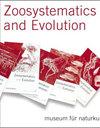在日本西南部琉球群岛海底洞穴中分离到的一种自由生活的海洋线虫,Fotolaimus cavus sp. nov.(线虫纲,蛭形线虫科,蛭形线虫科)
IF 0.9
2区 生物学
Q2 ZOOLOGY
引用次数: 0
摘要
Fotolaimus cavus sp. 11 .是在日本西南部琉球群岛宫古岛群下岛的一个名为Akuma-no-yakata的海底洞穴中被描述的。这是从日本海底洞穴中分离出的第一种自由生活的海洋线虫,也是Fotolaimus属的第三种。这个新种不同于它的同类,它的体型小,宽的两栖,长颊腔,长圆锥形的尾巴,和近弯曲的管骨。我们提供了修订的二分类键,以属的Oncholaiminae亚科和种的Fotolaimus。我们还分析了从日本水域采集的狐尾鲷和其他6种蠓科的核糖体小亚基RNA和细胞色素c氧化酶亚基I的部分DNA序列。基于核糖体小亚基RNA序列的最大似然分析系统发育树表明,Fotolaimus与Wiesoncholaimus以及Oncholaimus关系密切。这棵树的拓扑结构与以前的研究相似;然而,它提出了一种新的系统发育定位,即粘虫和圆虫的姐妹分支。本文章由计算机程序翻译,如有差异,请以英文原文为准。
A new species of free-living marine nematode, Fotolaimus cavus sp. nov. (Nematoda, Oncholaimida, Oncholaimidae), isolated from a submarine anchialine cave in the Ryukyu Islands, southwestern Japan
Fotolaimus cavus sp. nov. was described from a submarine anchialine cave called Akuma-no-yakata on the Shimoji Island, Miyako Island Group, Ryukyu Islands, southwestern Japan. This is the first free-living marine nematode isolated from a submarine cave in Japan, and the third species of the genus Fotolaimus . This new species differs from its congeners by its small body size, wide amphids, long buccal cavity, long conico-cylindrical tail, and proximally curved gubernaculum. We provide amended dichotomous keys to genera in the subfamily Oncholaiminae and species in Fotolaimus . We also analyzed partial DNA sequences encoding ribosomal small subunit RNA and cytochrome c oxidase subunit I from Fotolaimus cavus sp. nov. and six other species of Oncholaimidae collected from Japanese waters. The phylogenetic tree based on the ribosomal small subunit RNA sequences using maximum likelihood analysis suggested a close relationship between Fotolaimus and Wiesoncholaimus as well as Oncholaimus . The topology of the tree was similar to those from previous studies; however, it suggested a new phylogenetic position of Adoncholaimus as a sister clade for Viscosia and Oncholaimus .
求助全文
通过发布文献求助,成功后即可免费获取论文全文。
去求助
来源期刊

Zoosystematics and Evolution
ZOOLOGY-
CiteScore
3.50
自引率
5.00%
发文量
34
审稿时长
16 weeks
期刊介绍:
Zoosystematics and Evolution, formerly Mitteilungen aus dem Museum für Naturkunde in Berlin, is an international, open access, peer-reviewed life science journal devoted to whole-organism biology. It publishes original research and review articles in the field of Metazoan taxonomy, biosystematics, evolution, morphology, development and biogeography at all taxonomic levels. The journal''s scope encompasses primary information from collection-related research, taxonomic descriptions and discoveries, revisions, annotated type catalogues, aspects of the history of science, and contributions on new methods and principles of systematics. Articles whose main topic is ecology, functional anatomy, physiology, or ethology are only acceptable when of systematic or evolutionary relevance and perspective.
 求助内容:
求助内容: 应助结果提醒方式:
应助结果提醒方式:


